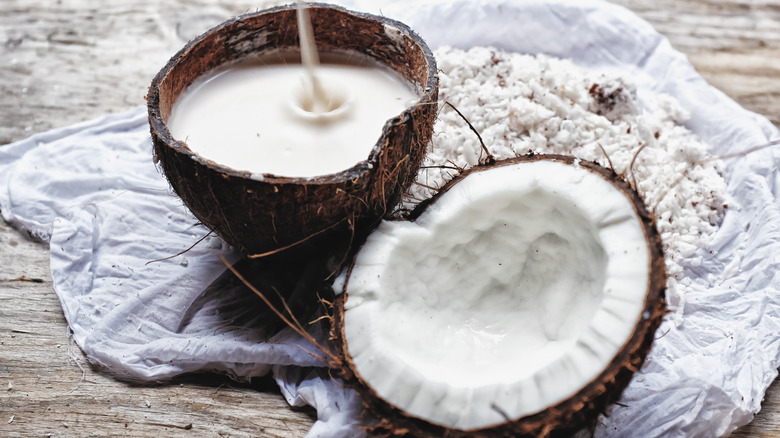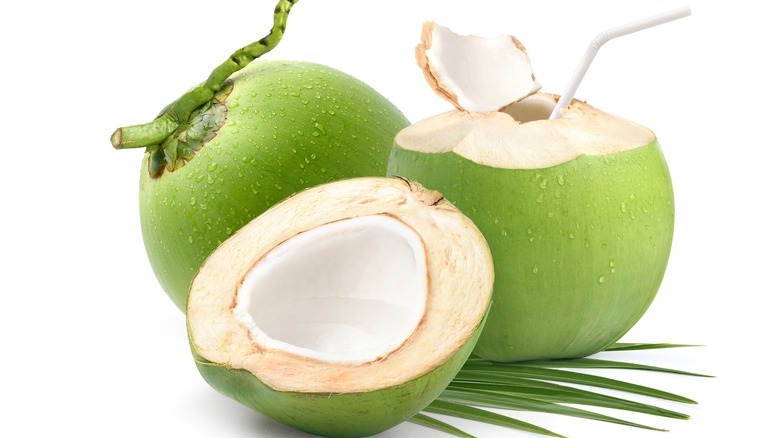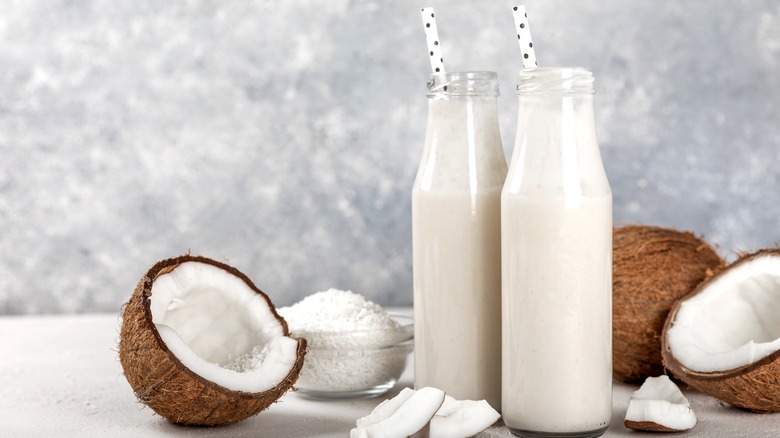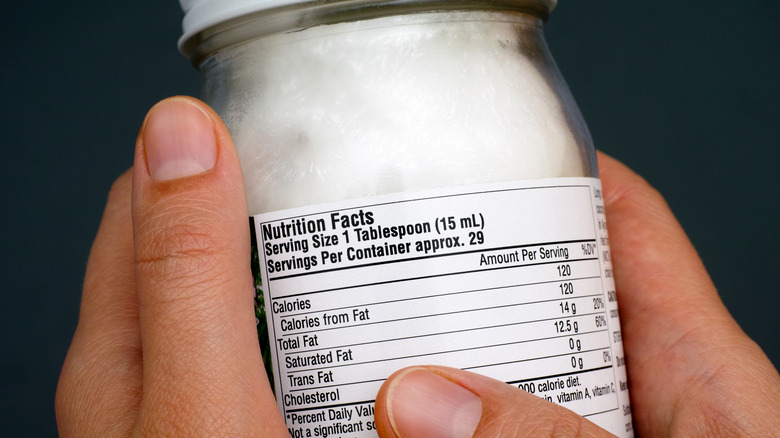What's The Actual Difference Between Coconut Milk And Coconut Water?
The mighty coconut wears many hats these days — from oils and creams to sugar and flour, or milk and water. People are always on the hunt for non-dairy alternatives for cooking, and coconut has taken on that task with gusto.
Because of its many hats, unique flavor, and appearance, coconut is also notoriously hard to categorize. They're sweet but not exactly a fruit as we know them to be. And although it's classified as a tree nut per the FDA, the palm tree on which the coconut grows is not technically a tree at all. The coconut is quite a conundrum. It's actually considered a drupe. A drupe is a type of fruit with a single seed that is protected by a hard shell (via Library of Congress). In addition to its seed, the inside of a coconut drupe offers up both water and edible flesh.
If you've ever cracked open a can of coconut milk and found a glob of cream stuck to the side amidst the thin liquid, you've witnessed the distinction between coconut milk and coconut water firsthand. But what exactly is the difference between the two?
Water is naturally found inside the coconut
Coconut water is naturally found inside the fruit itself. It is a clear liquid that makes up the seed's endosperm — or the food store for the coconut embryo. In other plants, the maturation process that hardens the endosperm ends up filling the entire cavity. However, in coconuts, only part of the liquid endosperm hardens into the white flesh. The space that is leftover remains filled with what we call coconut water, according to an article published in Molecules in 2009.
As a coconut ripens, more and more flesh forms from the liquid. For this reason, the fluid in young, green coconuts is most abundant and hydrating, per Healthline. The more mature — brown and hairy — coconuts that many people are more familiar with are beloved for their firm, white, and sweet flesh.
Coconut water is usually found bottled in the drink section of the store or you can enjoy it straight out of the fruit with a straw.
Milk is processed from the meat of the coconut
Coconut milk is processed from the meat of the fruit. It is made by grating the solid white endosperm either with or without the addition of water, depending on the desired consistency. The amount of water added determines the style of the milk — from light and diluted, to a cream or concentrate (via Business Diary).
Fresh coconut milk spoils fast because of its high oil levels, moisture content, and organic compounds. To counteract these factors and extend the shelf-life, it undergoes sterilization via high heat during the canning process (per Science Direct).
Coconut milk can be found canned on store shelves, in cartons in the refrigerated section, or powdered. Many of the canned varieties contain emulsifiers to keep the cream and water from separating. Boxed and refrigerated coconut milk may also contain additives but is usually free of the stabilizing chemicals found in canned coconut milk. Powdered coconut milk is a versatile option because you can control the amount of added water and the resulting consistency, which is great for baking (via The Kitchn).
There are drastic nutritional differences
When it comes to nutrition, the differences between coconut milk and water are vast. It's no surprise to learn that coconut water is mostly water, whereas coconut milk is mostly fat. Even though the main difference between the two is the fat content, there are also substantial variances in calories, sugar, carbs, and protein.
Side-by-side, a one-cup serving of unsweetened coconut milk has 57.1 grams of fat compared to the 0.48 grams found in unsweetened coconut water. A cup of coconut water has 45.6 calories, whereas a cup of processed coconut milk contains 552 calories. The amount of sugar is comparable but coconut water contains a little less with 6.26 grams compared to the 8 grams found in coconut milk. The carbohydrate content of coconut water is 8.9 grams next to coconut milk's 13.3 grams. And there is significantly more protein in coconut milk with 5.5 grams per cup in comparison to 1.73 grams of protein in one cup of coconut water, according to USDA.
Per Medical News Today, coconut water is touted as a natural source of electrolytes like potassium — containing more than a banana. It also offers calcium and magnesium as well as antioxidants. According to Verywell Fit, coconut milk is not a significant source of vitamins and minerals because of the small quantities it's consumed in, but it does contain lauric acid, which has been speculated to improve cholesterol.
Different flavors and functions
In addition to the processing, appearance, and nutritional differences, coconut milk and water differ greatly in flavor and use. The two are not interchangeable in recipes and typically not consumed in the same manner.
Coconut milk is full-bodied and creamy. It's rarely drunk on its own and is mostly used as an alternative to cow's milk or a thickening agent. It adds depth and richness to curries and soups, a hint of sweetness to a smoothie, and is the classic base of a piña colada. It also serves as a plant-based option for baked goods, lending a slightly nutty and sweet moistness to the final product (via Foods Gal).
Coconut water is mainly consumed as a drink, and many often use it as a sports drink due to its electrolyte content and rehydrating qualities, per a crossover study published in the South East Journal of Tropical Medicine in 2007. The sodium content offers a saltiness to the thin, watery, and refreshing beverage, and it does not have much of a coconut flavor at all, per Cooking Chew. Rarely, if ever, will you come across a recipe that calls for coconut water.
The bottom line is that coconut milk is rarely drunk on its own and is mainly used for cooking and baking. Whereas, coconut water is mainly consumed as a drink and is rarely used in cooking and baking.




